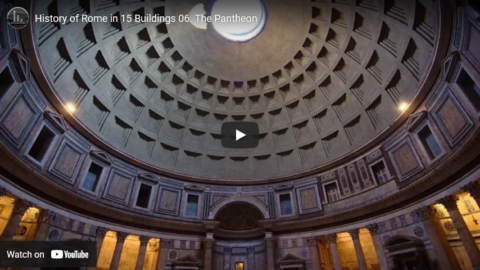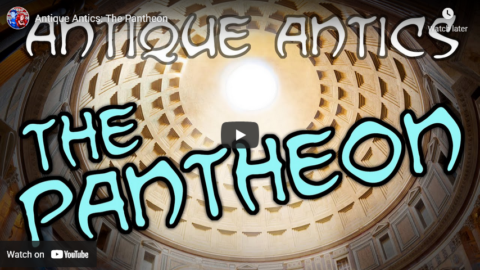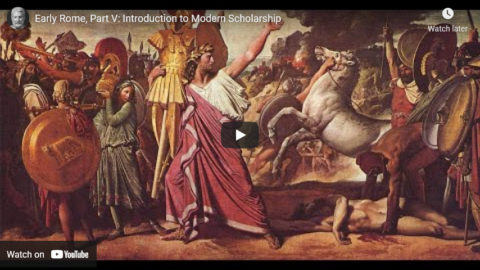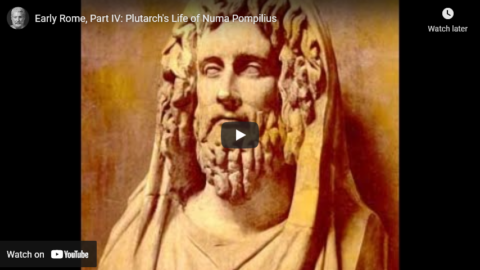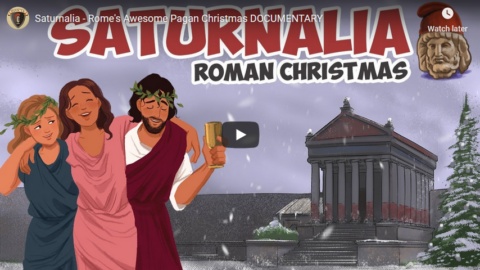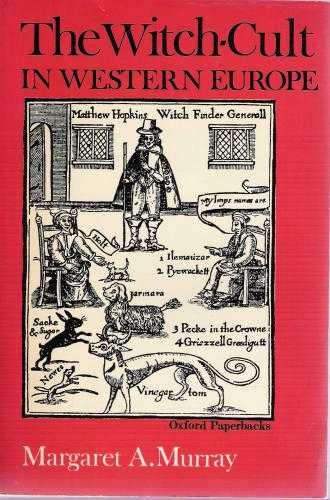toldinstone
Published 27 Sep 2018The sixth building in our History of Rome, the Pantheon, epitomizes the most stable Roman building material and the most restless Roman emperor – concrete and Hadrian, respectively. This episode discusses the peculiarities of both in some detail.
If you enjoyed this video, you might be interested in my book Naked Statues, Fat Gladiators, and War Elephants: Frequently Asked Questions about the Ancient Greeks and Romans. You can find a preview of the book here:
https://toldinstone.com/naked-statues…
If you’re so inclined, you can follow me elsewhere on the web:
https://www.reddit.com/r/AskHistorian…
https://www.instagram.com/toldinstone/To see the story and photo essay associated with this video, go to:
https://toldinstone.com/the-pantheon/Thanks for watching!
April 26, 2022
History of Rome in 15 Buildings 06. The Pantheon
April 6, 2022
QotD: Haruspicy and Augury in Roman religious observances
Perhaps the most important form of divination in Rome was haruspicy (which spell-check insists is not a word, but is). Performed by a haruspex, haruspicy was the art of determining the will of the gods by examining the entrails of animals – particularly sacrificed animals and most commonly (but not exclusively) the liver. The most common thing haruspicy might tell you is if the sacrifice was accepted: a malformed or otherwise ill-omened liver might indicate that the ritual had failed and that the god had refused the sacrifice.
Remember that the do ut des system is essentially one of bargaining with the gods, and the god you are bargaining with always has the option of simply refusing the bargain. This might mean some failure in the mechanics of the ritual (necessitating it be performed again), or that the god had been offended in some way, but it might also mean something more. A lot of sacrificial rituals were done at the outset of important tasks – before battles, political events, etc. What the god might be telling you then with a failed sacrifice is “DO NOT PROCEED”.
The practitioner is given a bit of wiggle room on how to interrupt a failed sacrifice in this way: it might mean “don’t attack at all”, but it might also mean “don’t attack now”. Roman generals, ready to attack, might repeat the same ritual over and over again, like a runner at the start of a race waiting for the “go” signal.
But more information was potentially available, because the exact nature of the liver and its quality might signal more things. In Rome, it was understood that the very best knowledge in this regard came from the Etruscans (an example of how antiquity lends credibility to ritual – Etruscan religion was old even to the Romans, and thus had acquired a strong reputation). The reading of a liver could be complex: we find “liver models” from both Italy and the Near East with guidance on how to interpret different parts of the liver of a sacrificed animal. This could be fairly specific: famously, it was haruspex who warned Caesar about the danger of the Ides of March (Seut. Caes. 81.2).
Another key system for divining the will of the gods in Rome was augury, the reading of the flights of birds (mostly, there are actually other categories of auspicia); doing so is called taking the auspices, and the men who do so are the augurs. Augurs were particularly important in political matters, taking the auspices for elections and the like. Unfavorable auspices could invalidate even a consular election: the gods get a vote too.
Bret Devereaux, “Collections: Practical Polytheism, Part III: Polling the Gods”, A Collection of Unmitigated Pedantry, 2019-11-08.
March 1, 2022
QotD: The Great Library of Alexandria
… we don’t know exactly who founded the Library and we aren’t clear on precisely when. What is clear is that it was quite early in the history of what was to become the great city of Alexandria and that its establishment made the city a centre of learning for centuries to come. What should also be made clear, however, is that it was not actually a “library” that was established at all. The “Great Library” that we refer to was a collection of books associated with a religious shrine – the Musaeum or Mouseion. This institution was, as the name implies, dedicated to the Nine Muses: Clio (history), Urania (astronomy), Calliope (epic poetry and song), Euterpe (lyric song), Polyhymnia (sacred song), Erato (erotic song), Melpomene (tragedy), Thalia (comedy) and Terpsichore (dance). The temple to the Muses had a dedicated priest appointed by the Ptolemaic kings and was the centre of a complex that included an exhedra, or hall, with recesses and seats for lectures and private study. According to the only and rather brief surviving description, given by Strabo in the early first century AD, it also included a communal dining hall with kitchens, a dormitory and other residential apartments, extensive gardens decorated with statues and a shaded walk. What we call the “Great Library” was a collection of books gathered to service the scholars who were housed and worked in the Mouseion and it was stored partially in the complex itself and, later, on other sites including at least three “daughter libraries”. The popular image of the Great Library as an echoing hall lined with shelves of scrolls with desks and tables for scholars is almost certainly inaccurate. That kind of library, which is still the model for many traditionally-styled libraries today, was developed much later by the Romans and the Mouseion would instead have had “a colonnade with a line-up of rooms behind … the rooms would serve for shelving the holdings and the colonnade provide space for the readers.” (Lionel Casson, Libraries of the Ancient World, Yale University Press, 2001, p. 34)
The Mouseion at Alexandria was far from the only shrine to the Muses in the ancient world, nor was it the only one with an associated centre of study. Pythogoras had recommended the establishment of a shrine to the Muses for the promotion of learning on his first arrival on Croton, for example and the Seleucid kings built one at Antioch in the late second century BC, with an attendant centre for study and a library. The fact that the Great Library was actually associated with a religious shrine is something that is ignored or glossed over in many modern accounts. [Carl] Sagan […] mentions about how one of the “daughter libraries” was the Serapeum, which was the temple of Serapis, but he skips around this in a rather gingerly manner. He says the Serapeum was “once a temple, but was later reconsecrated to knowledge”. This is nonsense. The Serapeum was always a temple and was not “reconsecrated” to anything. Libraries were often established as adjuncts to temples but it seems Sagan was attempting to distance the “annex” of the Great Library from the temple in which it sat because this did not quite fit his theme of secular knowledge’s superiority to “mysticism”. Like the Serapeum, the Mouseion was a temple with a research institution and a book collection associated with it.
This aside, the Mouseion really was primarily a research institution and its associated book collection – which we will continue to refer to by the shorthand expression the “Great Library” – was clearly one of if not the most extensive in the ancient world (more on that below). Many famous ancient scholars worked in the Mouseion, including Eratosthenes and probably Ptolemy. But several who are often claimed as working there (or even as being “librarians” of the Great Library, no less) clearly did not. Sagan’s hymn of praise says that Hipparchus studied there, but he seems to have only used some of the books from the collection and there is no evidence he ever even visited from his home on Rhodes. Likewise Sagan says Archimedes worked there, but there is no clear evidence for this and what little we know of Archimedes’ life indicates he spent it in Syracuse. Of the others Sagan mentions, Euclid and Herophilos may have studied there, depending on when the Mouseion was established and Dionysius of Thrace is another maybe, though more likely. On the whole, Sagan’s roll call of great scholars is mainly hyperbole and speculation rather than historical fact. The other figure who is regularly invoked as being associated with the Great Library, and even presented as its “last librarian”, is (again) Hypatia. This is despite the fact that both the Great Library and its daughter library in the Serapeum had ceased to exist by her time.
Tim O’Neill, “The Great Myths 5: The Destruction Of The Great Library Of Alexandria”, History for Atheists, 2017-07-02.
January 8, 2022
Antique Antics: The Pantheon
Overly Sarcastic Productions
Published 7 Jan 2022It’s a good dome, simple as that.
SOURCES & Further Reading: The Great Courses lectures: “The Most Celebrated Edifice – The Pantheon” from Understanding Greek and Roman Technology by Stephen Ressler, and “Roman Art and Architecture” from The Roman Empire: From Augustus to The Fall of Rome by Gregory Aldrete. “The Pantheon” by Chris Legare via ATouchOfRome https://www.atouchofrome.com/the_pant…. Additionally, I have a university degree in Classical Studies.
Our content is intended for teenage audiences and up.
PATREON: https://www.Patreon.com/OSP
PODCAST: https://overlysarcasticpodcast.transi…
DISCORD: https://discord.gg/osp
MERCH LINKS: http://rdbl.co/osp
OUR WEBSITE: https://www.OverlySarcasticProductions.com
Find us on Twitter https://www.Twitter.com/OSPYouTube
Find us on Reddit https://www.Reddit.com/r/OSP/
December 18, 2021
Saturnalia
Historia Civilis
Published 17 Dec 2016Io, Saturnalia!
Patreon | http://historiacivilis.com/patreon
Donate | http://historiacivilis.com/donate
Merch | http://historiacivilis.com/merch
Mailing List | http://historiacivilis.com/mailinglist
Twitter | http://historiacivilis.com/twitter
Website | http://historiacivilis.comMusic is:
“I //\\ I,” by Discount Fireworks
October 31, 2021
Soul Cakes & Trick-or-Treating
Tasting History with Max Miller
Published 30 Oct 2020Help Support the Channel with Patreon: https://www.patreon.com/tastinghistory
Follow Tasting History here:
Instagram: https://www.instagram.com/tastinghist…
Twitter: https://twitter.com/TastingHistory1
Reddit: r/TastingHistoryLINKS TO INGREDIENTS & EQUIPMENT**
Canon EOS M50 Camera: https://amzn.to/3amjvwu
Canon EF 50mm Lens: https://amzn.to/3iCrkB8
Currants: https://amzn.to/2T3qItA
Nutmeg: https://amzn.to/2IGDlcb
Clove: https://amzn.to/3dyNWRP
Mace: https://amzn.to/31j625h
Saffron: https://amzn.to/3560pbP
KitchenAid Stand Mixer: https://amzn.to/37hsboALINKS TO SOURCES**
The Customs and Traditions of Wales by Trefor Owen: https://amzn.to/37gi6bt
The Book of Hallowe’en by Ruth Eda Kelley: https://amzn.to/3dDb41i
Trick or Treat: A History of Halloween by Lisa Morton: https://amzn.to/348t0xQ**Amazon offers a small commission on products sold through their affiliate links, so each purchase made from this link, whether this product or another, will help to support this channel with no additional cost to you.
Editor: WarwicSN – https://www.youtube.com/WarwicSN
SOUL CAKES
ORIGINAL 16TH CENTURY RECIPE (From Elinor Fettiplace’s Receipt Book)
To make Cakes
Take flower & sugar & nutmeg & cloves & mace & sweet butter & sack & a little ale barm, beat your spice & put in your butter & your sack, cold, then work it well all together & make it in little cakes & so bake them, if you will you may put in some saffron into them or fruit.MODERN RECIPE
INGREDIENTS
– ½ Cup Lukewarm Ale (Below 100°F/38°C)
– 1 Teaspoon Yeast
– 3 Cups (360g) Flour
– ½ Cup (100g) Sugar
– 4 Tablespoons Butter Softened
– ½ Teaspoon Salt (if you’re using unsalted butter)
– ¼ Teaspoon Nutmeg
– ¼ Teaspoon Clove
– ¼ Teaspoon Mace
– ⅓ Cup Sack or Sherry
– 1/4 Teaspoon Saffron Threads (optional)
– 3/4 Cup Dried Fruit, plus more for decoration. (Optional)
– 1 Egg for Egg Wash (Optional)METHOD
1. Create an “ale barm” by mixing the yeast with the lukewarm ale and letting sit for 10 minutes. If you are using saffron, mix that into the sherry and let steep.
2. In a large bowl, mix the flour, sugar, salt, nutmeg, clove, and mace together. Add the yeasted ale and work it in. Then work in the softened butter and the sack with saffron along with any fruit you are using. Mix until everything the dough comes together, then knead for 5 – 12 minutes. The longer you knead, the more bread-like the cakes will be, but the more they will rise.
3. Allow dough to rise for 1 hour (it will likely not double in size), then punch the dough down and form into small cakes. Cover and allow the cakes to rise for another 20 minutes while you preheat the oven to 400°F/200°C.
4. When the cakes have puffed up, add the optional egg wash and/or additional fruit, or form a cross on the top of each cake using the back of a knife (do not cut the cross in). Then back fro 20 minutes. When baked, allow to cool before serving.#tastinghistory #halloween #soulcakes
September 21, 2021
Early Rome, Part V: Introduction to Modern Scholarship
Thersites the Historian
Published 6 Sep 2021In this video, we look at what modern scholars tend to think about early Rome and some of the ways in which they approach this fraught topic.
Patreon link: https://www.patreon.com/thersites
PayPal link: paypal.me/thersites
Discord: https://discord.gg/QCaXXFr
Brave Browser: https://brave.com/noa557
Twitter link: https://twitter.com/ThersitesAthens
Minds.com link: https://www.minds.com/ThersitestheHis…
Steemit/dtube link: https://steemit.com/@thersites/feed
BitChute: https://www.bitchute.com/channel/jbyg…
September 13, 2021
Early Rome, Part IV: Plutarch’s Life of Numa Pompilius
Thersites the Historian
Published 5 Sep 2021In this video, we look at how the philosopher Plutarch dealt with early Rome when he covered the life and times of Numa Pompilius, the most significant of Rome’s cultural heroes.
Patreon link: https://www.patreon.com/thersites
PayPal link: paypal.me/thersites
Discord: https://discord.gg/QCaXXFr
Brave Browser: https://brave.com/noa557
Twitter link: https://twitter.com/ThersitesAthens
Minds.com link: https://www.minds.com/ThersitestheHis…
Steemit/dtube link: https://steemit.com/@thersites/feed
BitChute: https://www.bitchute.com/channel/jbyg…
April 10, 2021
Miscellaneous Myths: Loki
Overly Sarcastic Productions
Published 9 Apr 2021I started researching this goddamn video in june of 2019. I was so young. So innocent. This video is a precious relic of The Before Times, and unlike those inconsiderate vikings, I went out of my way to take *actual notes!*
Our content is intended for teenage audiences and up.
PARTIAL TRACKLIST: Starfall, Hall Of The Mountain King, Sky Becomes Water, Flight Of The Silverbird, Lacrimosa, Reign Of Vengeance, He Who Brings The Night
“Scheming Weasel” Kevin MacLeod (incompetech.com)
Licensed under Creative Commons: By Attribution 3.0
http://creativecommons.org/licenses/b…“Elevator” Kevin MacLeod (incompetech.com)
Licensed under Creative Commons: By Attribution 3.0
http://creativecommons.org/licenses/b…PATREON: https://www.Patreon.com/OSP
PODCAST: https://overlysarcasticpodcast.transi…
DISCORD: https://discord.gg/osp
MERCH LINKS: http://rdbl.co/osp
OUR WEBSITE: https://www.OverlySarcasticProductions.com
Find us on Twitter https://www.Twitter.com/OSPYouTube
Find us on Reddit https://www.Reddit.com/r/OSP/
December 25, 2020
“Swedish Pagans” – Vikings & The Russ – Sabaton History 099 [Official]
Sabaton History
Published 24 Dec 2020It was a sword-age, a spear-age — an age when fearsome Northmen, savage Vikings, and mysterious pagans from across the sea haunted the shores of northern Europe. The Swedish pagans, believing in the fate of the old Norse gods, traveled south across the Baltic Sea and deep into modern-day Russia. With their sleek longships, they sailed along the big rivers, ever southwards to reach Miklagard. Miklagard — the Great City — that was Constantinople, where the Swedish Pagans sold slaves and goods from the north for silver and coin. Those who made the long hazardous journey and survived the treacherous country were to be rich men.
Support Sabaton History on Patreon: https://www.patreon.com/sabatonhistory
Listen to “Swedish Pagans” on the album The Art of War: https://music.sabaton.net/TheArtOfWar
Listen to Sabaton on Spotify: http://smarturl.it/SabatonSpotify
Official Sabaton Merchandise Shop: http://bit.ly/SabatonOfficialShopHosted by: Indy Neidell
Written by: Markus Linke and Indy Neidell
Directed by: Astrid Deinhard and Wieke Kapteijns
Produced by: Pär Sundström, Astrid Deinhard and Spartacus Olsson
Creative Producer: Maria Kyhle
Executive Producers: Pär Sundström, Joakim Brodén, Tomas Sunmo, Indy Neidell, Astrid Deinhard, and Spartacus Olsson
Community Manager: Maria Kyhle
Post-Production Director: Wieke Kapteijns
Editor: Karolina Dołęga
Sound Editor: Marek Kamiński
Maps by: Eastory – https://www.youtube.com/c/eastory
Archive: Reuters/Screenocean – https://www.screenocean.comSources:
Swedish National Heritage Board
Kulturhistorisk museum
Museum of Cultural History, part of the University of Oslo, Norway
Pictures of Runestone courtesy of: Berig, RJürgen Howald & Bjoertvedt from Wikimedia
AU Library, Campus Emdrup, http://galleri.au.dk/aul/#14891850309…
Longship sketch with a keel courtesy of Cornelis from Wikimedia
Map from 878 courtesy of Hel-hama – from WikimediaAll music by: Sabaton
An OnLion Entertainment GmbH and Raging Beaver Publishing AB co-Production.
© Raging Beaver Publishing AB, 2019 – all rights reserved.
December 24, 2020
Saturnalia – Rome’s Awesome Pagan Christmas
Invicta
Published 23 Dec 2020Celebrate an awesome pagan Christmas with the Roman Saturnalia! The first 100 people to go to https://www.blinkist.com/invicta are going to get unlimited access for 1 week to try it out. You’ll also get 25% off if you want the full membership.
In this history documentary we cover a very special Roman Holiday, the Saturnalia. It was a hugely popular winter festival which dominated the ancient world and in many ways created the Christmas that we celebrate today!
We begin the episode with a discussion about the origins of Saturnalia as a harvest festival. In these early years it was celebrated whenever the last of the crops was brought with a special thanks being offered to the God of harvest, Saturn. The Romans did so at the temple of Saturn by offering a procession of bulls and hosting a grand feast. Over the years however the traditions would grow by importing Greek customs, pinning the date to December 17th and extending the holiday to a full week!
We then cover the history of Saturnalia at its full glory by recreating the experience. This begins with the traditional parade and feast on the first day after which all work was banned. The following days were filled with endless parties and feasts. These featured all kinds of familiar staples of Christmas like gift giving, hat wearing, and singing. However there were many more, wilder traditions as well. IO SATURNALIA!!!
We finally conclude with the rise of Christianity and the history of Christmas which coopted this popular pagan holiday. Stay tuned for more How They Did It episodes on the history of daily life in the past.
Bibliography and Suggested Reading:
Daily Life in the Roman City by Gregory Aldrete
Popular Culture in Ancient Rome by Jerry Toner
As the Romans Did by Jo-Ann Shelton
Festivals and Ceremonies of the Roman Republic by H. H. Scullard
The Roman Community at Table During the Principate by John Donahue#Saturnalia
#Rome
#History
December 15, 2020
History Summarized: Spread of Christianity
Overly Sarcastic Productions
Published 10 Jan 2017Things I learned when making this video: 1) when your script goes beyond 4 single-spaced pages, you’re heading into the danger zone 2) Gregorian Chants are awesome and you should totally listen to them, 3) editing always takes longer than you’d hope 4) self care is huffing frankincense for breakfast lunch and dinner and single-handedly sacking a levantine city!
Have a question about something I mentioned, or maybe something I might have left out? Leave it down below and I’ll do my best to respond!
PATREON: https://www.patreon.com/OSP
MERCH LINKS:
Shirts – https://overlysarcasticproducts.threa…
All the other stuff – http://www.cafepress.com/OverlySarcas…Find us on Twitter @OSPYouTube!
twitter.com/OSPyoutube
October 24, 2020
Andrew Sullivan on the potentials of therapeutic use of psilocybin
In the last free edition of his Weekly Dish newsletter — and probably the last time I’ll be able to link to it — Andrew Sullivan discusses the medical trials and legalization initiatives for psilocybin along with some of the history of its use in the Elusinian Mysteries in ancient Greece:
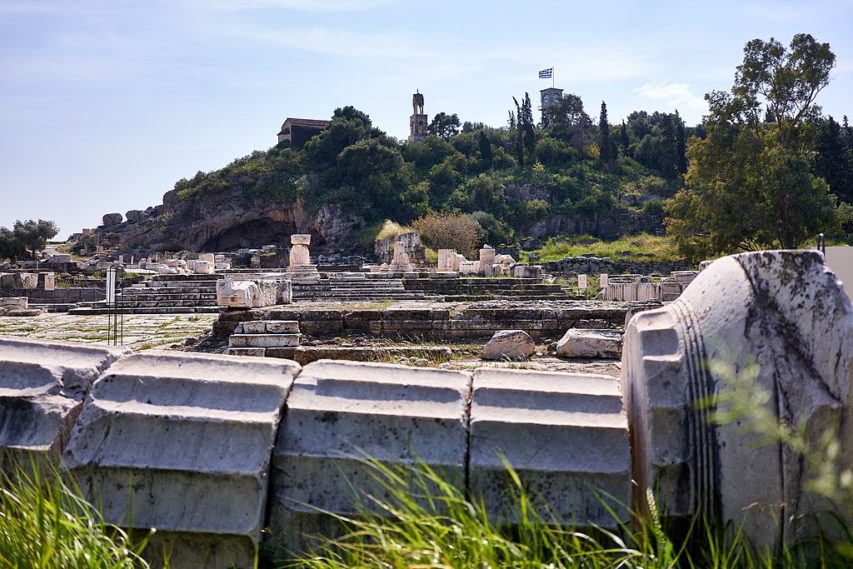
At the archaeological site of the Sanctuary of Demeter at Eleusis. The information board on the left stands on what was once the courtyard of the sanctuary. Over the staircase behind it stood the Greater Propylaea. Next to the cavern in the background stood the Sanctuary of Pluto (who abducted Persephone, Demeter’s daughter). The cavern represents the entrance to the Underworld. The path to the left of the cavern leads to the Telesterion where the faithful were initiated to the Eleusinian mysteries. The brown building up on the hill (left) is a church dedicated to the Virgin Mary (Church of Panagitsa Mesosporitissa) and stands over the area of the Telesterion.
Photo by George E. Koronaios via Wikimedia Commons.
There are many ways in which this election might portend the future, but there’s a seemingly small issue — only on the ballot in Oregon and the District of Columbia — that’s a sleeper, it seems to me, and worth keeping an eye on. It’s the decriminalization of naturally-occurring psychedelics, in particular, psilocybin, the psychoactive ingredient in some mushrooms which have long been dubbed “magic.”
This doesn’t come out of the blue. Huge strides have been taken in the last few years in the decriminalization of cannabis, with 33 states allowing medical use, of which 11 allow recreational as well. The FDA recently greenlit clinical trials for psilocybin as a “breakthrough therapy” for depression — with some wildly impressive results. Books like Michael Pollan’s magisterial How To Change Your Mind have helped shift the reputation of psychedelics from groovy, counter-cultural weirdness to mature, spiritual, and regulated mental health treatment. Ketamine — previously a party drug and an animal tranquilizer — has shown more promise as an anti-depressant than any therapy since the mid-1990s.
The familiar worry, of course, is that we might be ushering in an era of wild drug experimentation, with unforeseen and unknowable results. Some people fear that relaxing some of the legal restrictions on things that grow in nature could lead to social disruption or higher levels of addiction or worse. The great popularizer of psychedelics, Aldous Huxley, gave us a somewhat sobering description of what might be our future in Brave New World, and many in the West have been terrified of these substances for quite a while.
But new research suggests that this shift toward integrating psychedelics into a healthy, responsible life for Westerners may not be new at all. It would, in fact, be a return to a civilization that used these substances as a bulwark of social and personal peace. New literary investigations of ancient texts, new — and re-examined — archeological finds, and cutting edge bio-chemical technology that can detect and identify substances in long-buried artifacts, suggest that deploying psychedelics would, in fact, be a return to a Brave Old World we are only now rediscovering.
We’ve long known that human knowledge of psychedelic aspects of nature goes back into pre-history; and use of them just as far. But perhaps the most surprising find in this new area of research is that sacred tripping was not simply a function of prehistoric religious rituals and shamanism, but an integral, even central part, of the world of the ancient Greeks. The society that remains the basis for so much of Western civilization seems to have held psychedelics as critical to its vision of human flourishing. And that vision may have a role to play in bringing Western civilization back into balance.
A breakthrough in understanding this comes in the form of a rigorously scholarly new book, The Immortality Key: The Secret History of the Religion With No Name, by Brian Muraresku. What he shows is the centrality of psychedelic use for the ancient Greeks, in an elaborate and mysterious once-in-a-lifetime ceremony at the Temple of Eleusis, a short distance from Athens. We’ve long known about this temple of the Mysteries, as they were known, and the rite of passage they offered — because it’s everywhere in the record. Many leading Greeks and Romans went there, including Plato and Marcus Aurelius. Here is Cicero, no less, in De Legibus:
For it appears to me that among the many exceptional and divine things your Athens has produced and contributed to human life, nothing is better than those Mysteries. For by means of them we have been transformed from a rough and savage way of life to the state of humanity, and been civilized. Just as they are called initiations, so in actual fact we have learned from them the fundamentals of life, and have grasped the basis not only for living with joy, but also for dying with a better hope.
September 5, 2020
History Summarized: The Viking Age
Overly Sarcastic Productions
Published 4 Sep 2020The Vikings are enjoying a new wave of enthusiasm in popular culture, but these seafaring Norsemen are still quite clearly a misunderstood force in medieval European history. So let’s take a wide look at the European world during The Viking Age!
Check out Yellow’s livestreams over at https://Twitch.tv/LudoHistory
SOURCES & Further Reading: The Vikings by Walaker Nordeide and Edwards, Vikings: A Very Short Introduction by Richards, Age of the Vikings and The Conversion of Scandinavia by Winroth, The Vikings By Harl via The Great Courses, The Viking World by Graham-Campbell, The Viking Way by Price.
This video was edited by Sophia Ricciardi AKA “Indigo”. https://www.sophiakricci.com/
Our content is intended for teenage audiences and up.
DISCORD: https://discord.gg/kguuvvq
PATREON: https://www.Patreon.com/OSP
MERCH LINKS: https://www.redbubble.com/people/OSPY…
OUR WEBSITE: https://www.OverlySarcasticProductions.com
Find us on Twitter https://www.Twitter.com/OSPYouTube
Find us on Reddit https://www.Reddit.com/r/OSP/
From the comments:
Ludohistory
23 hours ago (edited)
Thanks so much for having me on and letting me help out! It was a lot of fun (even if I talked a little too fast sometimes)! To clarify a piece that I know I did cover too briefly — missionary trips to Scandinavia occurred in Denmark around 823, on the orders of Louis the Pious, and in Sweden in 829, when Ansgar, a Frankish monk, traveled to the town of Birka, where he found a very small Christian community, probably mostly enslaved or formerly enslaved people, and converted a couple of Norse people, including the town prefect. (The graveyard for that town, incidentally, is where the 10th century “female warrior” that made waves a few years ago was buried).There’s a lot we didn’t get a chance to talk about about the diaspora and its ending, so if there’s anything you all are curious on or find unclear, let me know here or on twitter 🙂
Finally, if you liked this, all the VODs for my personal streams (where I try to ramble about history in games) can be found by clicking on my name, and tomorrow I’ll be streaming CKIII on twitch (link in the description)!
August 27, 2020
Margaret Murray’s highly influential The Witch-Cult in Western Europe
In First Things, Francis Young discusses the impact Murray’s work had when it was published in the 1920s:
Just under a century ago, in 1921, one of the strangest books ever to be published by Oxford University Press appeared in print: The Witch-Cult in Western Europe by Margaret Alice Murray. By today’s academic standards — in fact, even by the standards of the 1920s — Murray’s book was filled with transparent flaws in methodology and research. Furthermore, the book’s author (a leading Egyptologist) was not qualified to write it. The few scholars then working on the history of European witchcraft dismissed Murray’s contribution. Yet in spite of this, The Witch-Cult in Western Europe became an instant hit and captured the imaginations of readers. Within three decades, the book had not only profoundly influenced cultural understandings of witchcraft, but also directly led to the rise of neopaganism and the foundation of a new religion, Wicca, that today has millions of adherents throughout the world.
Margaret Alice Murray (1863–1963) was born and brought up in British India — an upbringing that, as with so many Anglo-Indians of the nineteenth century, may have opened her mind to interests beyond Victorian culture. Determined to pursue a career of her own at a time when opportunities for women were limited, Murray tried out both nursing and social work before entering the progressive University College London in 1894, where she studied Egyptology under W. Flinders Petrie. Murray rapidly rose through the academic ranks, and by 1914, she was effectively running the Egyptology department. Her impressive achievements in advancing knowledge of ancient Egypt and higher education for women have, however, been largely overshadowed by her decision to take a detour into writing about European witchcraft.
In The Witch-Cult in Western Europe, Murray seized on some unusual testimonies in 16th-century Scottish witch trials to elaborate a radical theory: She claimed that what medieval and early modern people called witchcraft was, in fact, the last traces of a pagan fertility cult that originated in the Neolithic period. The witch trials of the 15th–17th centuries represented Christianity’s last attempt to stamp out this cult, which was practiced in secret covens (groups of thirteen people) who worshipped a horned god (who was mistaken for the devil). Knowledge of this cult was passed through families or, occasionally, to new initiates, but kept secret from the outside world.
Murray’s use of a single set of problematic sources from one country (Scotland) to argue that a previously unnoticed religion had existed since prehistory failed to meet basic historiographical and anthropological standards of research. She was given to making huge conceptual leaps on the basis of contentious interpretations of meager evidence. Using a small range of hostile trial records designed to discredit women accused of witchcraft (along with testimonies extracted under torture), Murray reconstructed what she believed were real religious practices lurking behind the demonological construct of the Witches’ Sabbath. In so doing, she brought together traditions of interpretation honed by the anthropologist Sir James Frazer (1854–1941), the author of The Golden Bough, and the French historian Jules Michelet (1798-1874). Murray followed Michelet in arguing that those accused of witchcraft were not the innocent victims of trumped-up charges, but were in fact adherents of a subversive cult; and she followed Frazer in her belief that prehistoric religious beliefs, associated with fertility, had survived into recent times.

